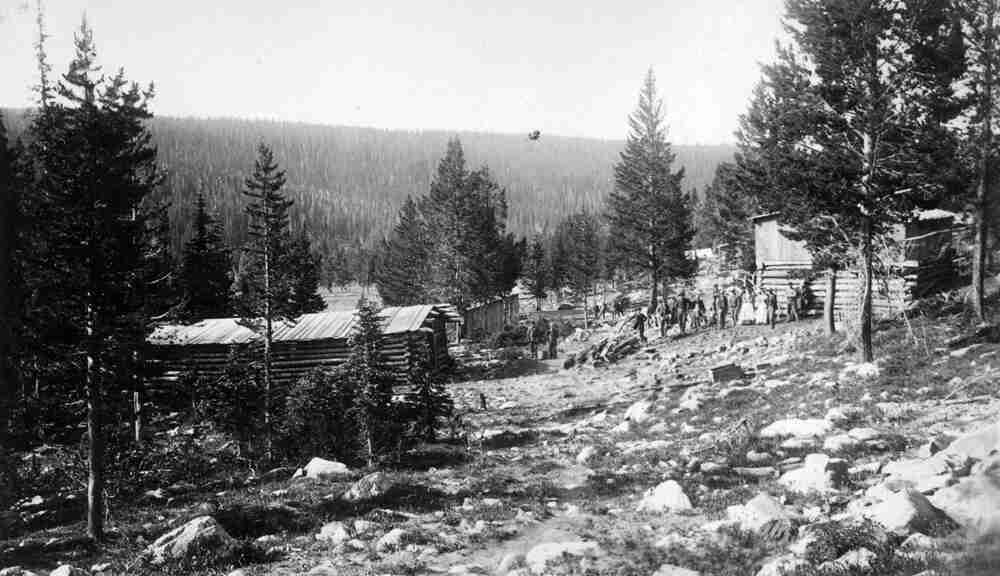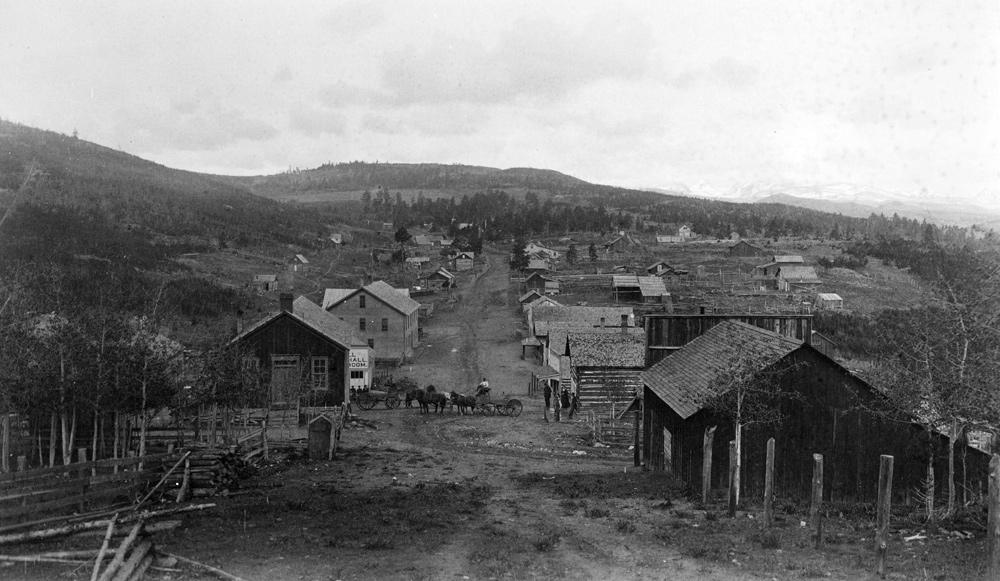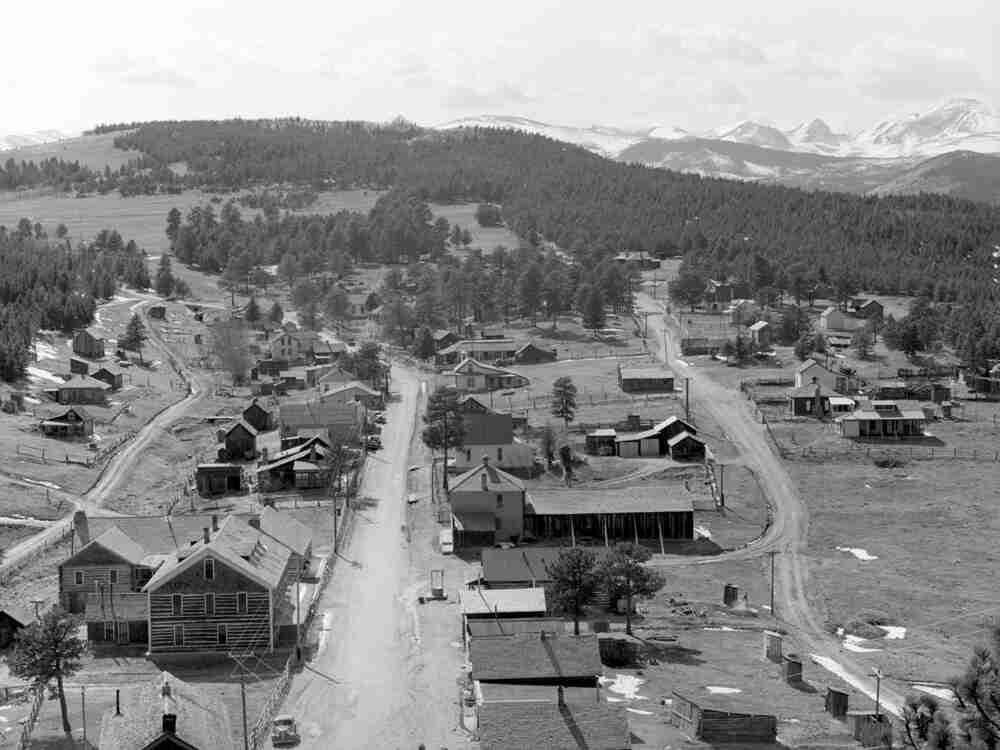Gold Hill
Full Article
Gold Hill was established in 1859 as the first permanent mining camp in the Colorado mountains. Located at an elevation of about 8,300 feet in Boulder County, the town experienced several booms and busts before settling into a small-scale tourist economy in the twentieth century. Today Gold Hill—which was listed on the National Register of Historic Places in 1989—has about 200 residents and continues to represent perhaps the best intact example in the state of an early mining community.
Mountain District No. 1
In the fall of 1858, the Colorado Gold Rush spurred Capt. Thomas Aikins to lead a party of about fifteen up the South Platte River toward Cherry Creek. On the way, they stopped at the ruins of Fort St. Vrain, an old fur trading post along the river. Aikins supposedly climbed the fort’s crumbling walls and looked west, where he saw an inviting valley at the base of the foothills. He led his party to what is now Settler’s Park in Boulder, where the Southern Arapaho leader Niwot (or Left Hand) allowed them to camp through the winter.
During the winter, Aikins’s son, James, and other members of the party started to explore the creeks above their camp. On January 16, 1859, they found gold in a tributary of Fourmile Creek. They called the stream Gold Run, and the mining camp that took shape on a nearby ridge became Gold Hill. After news of the find reached Denver, hundreds of prospectors rushed to Gold Hill, which became the first permanent mining town in the Colorado mountains. In February the Aikins party established Boulder City as a supply town, and on March 7, 1859, miners in Gold Hill organized Mountain District No. 1, the first mining district in what would become Colorado.
Gold Hill soon swelled to 1,500 residents, who mined roughly $100,000 of gold in their first year. The most famous and productive early find in Gold Hill was the Horsfall Lode, discovered in June 1859 by David Horsfall, William Blore, and Matthew McCaslin. That fall, Thomas J. Graham built the area’s first stamp mill. In May 1860, a fire destroyed the camp, but it was soon rebuilt at a new, better-sheltered site on the saddle between Gold Run and Lick Skillet Gulch.
As with many of Colorado’s earliest mining towns, Gold Hill declined quickly after its initial boom. The exhaustion of placer gold—easily accessible gold in streambeds—made mining more difficult and expensive, and the Civil War drained the town of prospectors and capital. Over the next five years, the Horsfall Lode almost single-handedly kept Gold Hill alive. By 1870 the town had only a handful of residents left.
Tellurium Boom
Gold Hill experienced a second and more sustained boom starting in 1872, when miners discovered gold and silver tellurides in the area. Tellurides contain tellurium, an element used in alloys. Prospectors again flocked to the foothills above Boulder, founding new towns such as Sunshine and Salina. Gold Hill revived and grew to more than 1,000 residents who quickly put up dozens of log and frame buildings. The earliest surviving buildings in Gold Hill date to this period, including the log cabins at 210 and 240 Horsfall Street. By 1873, the newly bustling town had a store, a post office, a school, and several boardinghouses. Charles Wentworth built a three-story log hotel, sometimes called the Miners Hotel or Grand Mountain Hotel.
Over the next decade, Gold Hill grew to include three general stores, a drugstore, a barbershop, a meat market, a pool hall, a livery stable, and seven saloons. The largest and most productive mine in Gold Hill during this era was the Slide Mine. Discovered by W. B. Pell in July 1875, it produced ores worth more than $2 million by 1910. Even during these years, however, Gold Hill’s growth was hampered by its remote location. All the approaches into town were too steep for a railroad, so the nearest station was two miles away. Without a railroad to haul ores and bring materials, the town’s development never took off.
After 1900 the quantity and quality of the ores around Gold Hill declined. Mining activity slowed, and the population dropped to about 200 by 1910. By that time, the mines around Gold Hill had produced ores worth a total of about $13 million. Over the next decade, mining in Gold Hill essentially stopped, and the town shrank to only fifty people. Many houses and businesses were abandoned. Mining experienced a brief revival during the Great Depression, when gold prices were high and labor was cheap. That minor boom ended when the government shut down gold mines during World War II, and most mines never reopened.
Preservation
With the rise of automobiles in the 1910s and 1920s, Gold Hill started to attract tourists who drove up the steep canyon roads from Boulder. In 1921, for example, a Chicago women’s group called the Blue Birds bought the Wentworth Hotel and turned it into a private summer retreat called the Blue Bird Lodge. Five years later, they built a log dining hall next to the lodge. Some mining cabins started to be converted into summer homes, but the tourist economy sprouting in Gold Hill was soon squashed by the Great Depression. For the next generation, the town survived as a small residential community. In 1962 Barbara and Frank Finn bought the Blue Bird Lodge and dining hall, which they renamed the Gold Hill Inn.
Gold Hill never died out. It also never experienced enough development to destroy the town’s early log buildings or change its mining-camp feel. In the 1960s, the growth of Boulder sparked concerns in Gold Hill about the effects of new development on the historic town. In 1968 residents banded together as the Gold Hill Organization to Safeguard the Town (GHOST), and in 1972 they won historic preservation zoning that allowed them to review and approve all permits for new construction in town. Gold Hill residents also have hindered development by resisting efforts to pave any of the approaches into town.
Historic preservation in Gold Hill remains an active concern. In the late 1990s, Historic Gold Hill opened a local history museum and archive with the help of a State Historical Fund grant. In 2000 land containing the ruins of the original townsite and the Horsfall Mine were listed for sale and threatened with development. The nonprofit Colorado Preservation Inc. named the site one of the state’s most endangered places to draw attention to it, and Boulder County soon bought the land to preserve it as open space.
The town faces threats from natural disasters as well as economic development. In September 2010, the massive Fourmile Canyon Fire broke out near Gold Hill. The fire burned a total of 168 houses and caused more than $200 million in damages across nearly 6,200 acres, making it one of the most destructive wildfires in Colorado history. The historic Gold Hill townsite was on the edge of the fire but survived without losing any houses.
 Today Gold Hill has about 200 residents and more than 30 historic buildings, many of which are made of logs and date back to the town’s late nineteenth-century mining boom. The town’s two main businesses are the Blue Bird Lodge and Gold Hill Inn—still run by the Finn family—and the Gold Hill General Store, which serves meals, sells a wide variety of items, and houses the town library. The town’s 1874 schoolhouse is still in use.
Today Gold Hill has about 200 residents and more than 30 historic buildings, many of which are made of logs and date back to the town’s late nineteenth-century mining boom. The town’s two main businesses are the Blue Bird Lodge and Gold Hill Inn—still run by the Finn family—and the Gold Hill General Store, which serves meals, sells a wide variety of items, and houses the town library. The town’s 1874 schoolhouse is still in use.
























